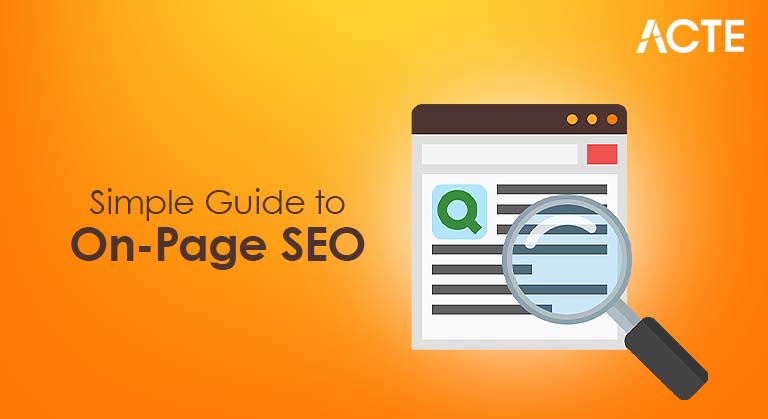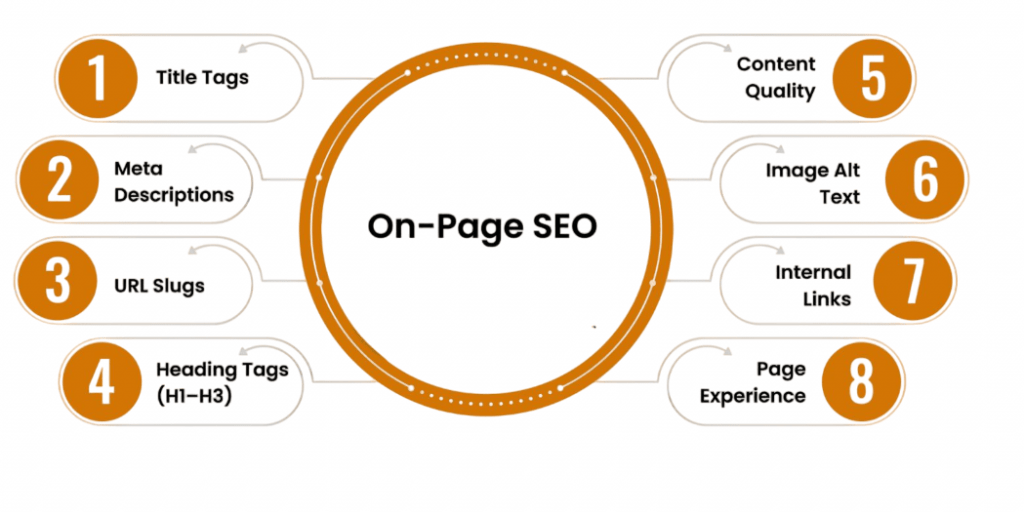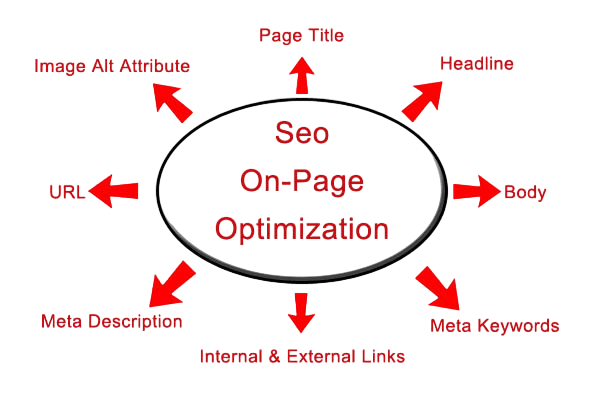
- Introduction
- What is On-Page SEO?
- Why is On-Page SEO Important?
- Key On-Page SEO Elements
- Step-by-Step On-Page SEO Process
- Common Mistakes in On-Page SEO
- Best Practices to Master On-Page SEO
- The Role of On-Page SEO in Your Digital Marketing Strategy
- Future Trends in On-Page SEO
- Conclusion
Introduction
In today’s online world, it’s very important for your website to appear at the top of search engine results. Getting there takes both skill and creativity. While strategies outside your site, like building backlinks, play a key role in improving your rankings, mastering on-page SEO is crucial. It provides the foundation for everything else. On-page SEO focuses on what happens directly on your site core principles emphasized in Digital Marketing Training, where learners master content structuring, metadata optimization, and HTML hygiene to improve site relevance, enhance user experience, and boost organic visibility from within the website itself. It ensures that your content is refined for both search engines and the users who visit your site. By optimizing your content this way, you can increase your chances of ranking higher, engaging visitors more effectively, and ultimately turning them into customers. This guide aims to help you understand on-page SEO. Whether you’re starting with the basics or want to improve your knowledge with more advanced techniques, this information will cover everything you need to get started and succeed online. Get ready to explore the essentials that will boost your website’s visibility and performance.
Ready to Get Certified in Digital Marketing? Explore the Program Now Digital Marketing Online Training Offered By ACTE Right Now!
What is On-Page SEO?
On-page SEO focuses on improving individual web pages so they rank higher in search engine results. This approach helps attract the right visitors through organic traffic, meaning people discover your site naturally rather than through paid ads. On-page SEO involves several key factors. These include optimizing your content, adjusting the HTML source code, and organizing the structure of your web pages. What distinguishes on-page SEO from off-page SEO is that off-page SEO includes elements like backlinks and external signals, while on-page SEO is entirely within your control core distinctions explored in Become a Digital Marketing Specialist, where learners master both sides of SEO strategy, from technical markup and content hierarchy to link-building and domain authority, equipping them to drive visibility and performance across search ecosystems. You have the ability to make changes directly on your site to boost its visibility and performance in search engines. By concentrating on on-page SEO, you can improve your website’s relevance, enhance user experience, and ultimately raise its search engine rankings.
Why is On-Page SEO Important?
- Improves Search Rankings: Google uses on-page elements to determine relevance.
- Boosts User Experience: Well-structured pages make content easier to read and navigate.
- Increases Click-Through Rates (CTR): Optimized titles and meta descriptions encourage more clicks.
- Supports Other SEO Strategies: Strong on-page foundations enhance the effectiveness of link building and technical SEO.
- Matches Search Intent: Google rewards pages that align with user queries.
- Keep under 60 characters
- Include your main keyword
- Make it compelling
- Keep under 160 characters
- Summarize content clearly
- Include target keyword
- Good: /on-page-seo-guide
- Bad: /page?id=1357abcx
- H1: Main title (only one per page)
- H2/H3: Subsections and subtopics
- Title
- First 100 words
- Headers
- Image alt text
- URL
- Throughout the body (naturally)
- Original, informative, and user-centric
- Solve the user’s intent
- Use rich media: images, videos, charts
- Avoid thin or duplicate content
- Use descriptive file names (e.g., on-page-seo-guide.jpg)
- Add alt attributes for accessibility and SEO
- Compress images to improve page load speed
- Helps Google understand site structure
- Passes link equity
- Increases time-on-site
- Keyword Stuffing: Overusing keywords unnaturally.
- Duplicate Content: Publishing identical content on multiple pages.
- Missing Meta Tags: Leaving title or meta descriptions empty.
- Weak Internal Linking: Poor site navigation or orphan pages.
- Slow Load Times: Affect user experience and rankings.
- Not Mobile-Friendly: Ignoring mobile optimization.
- Poor Content Structure: No headers, walls of text, low readability.
- Ignoring Search Intent: Content doesn’t align with what the user is looking for.
- Write for Humans, Optimize for Search: Content should be useful first, optimized second.
- Use Clear and Descriptive URLs: Avoid long strings of numbers or symbols.
- Structure Content Properly: Use bullet points, subheadings, and visual elements.
- Optimize Images and Media: Don’t let visuals slow down your site.
- Update Old Content: Keep your pages relevant and fresh.
- Use CTAs (Calls to Action): Guide users toward next steps like reading more or purchasing.
- AI and NLP (Natural Language Processing): Google’s algorithms (like BERT and MUM) focus on understanding context and meaning.
- User Experience (UX) Signals: Core Web Vitals and engagement metrics now influence rankings performance signals emphasized in Create a Digital Marketing Report, where marketers learn how to track loading speed, interactivity, visual stability, and user behavior to produce actionable insights that improve UX, boost SEO, and elevate site performance in search engine results.
- Visual Search Optimization: Image SEO and structured data are gaining importance.
- Voice Search: Optimizing for conversational and question-based queries.
- Entity-Based Search: Google focuses more on topics and context rather than just keywords.
To Explore Digital Marketing in Depth, Check Out Our Comprehensive Digital Marketing Online Training To Gain Insights From Our Experts!
Key On-Page SEO Elements
Core Components of On-Page SEO:
Title Tag
The clickable headline shown in search results.
Meta Description
A brief summary shown below the title tag.
URL Structure
Search-friendly URLs are concise, descriptive, and easy to read.
Header Tags (H1–H6)
Organize your content for readability and SEO.
Keyword Placement
Use your target keywords in:

Content Quality
Image Optimization
Internal Linking
Internal links to related content within your website.
External (Outbound) Links
Link to reputable sources to enhance content credibility and provide value.
Mobile-Friendliness
Ensure your page is responsive and easy to use on all devices.
Page Speed
Fast-loading pages improve user experience and rankings. Use tools like Google PageSpeed Insights to test and improve load times.
Schema Markup (Structured Data)
Helps search engines better understand your content and may enable rich snippets.
Step-by-Step On-Page SEO Process
Effective search engine optimization (SEO) requires a strategic, multi-step approach that starts with thorough keyword research using tools like Google Keyword Planner and Ahrefs. This helps identify the search terms used by the target audience. Once the keywords are found, creating high-quality, in-depth content that meets search intent is crucial audience alignment emphasized in Digital Marketing Training, where learners master keyword research, intent mapping, and content strategy to ensure every piece resonates with user needs, ranks effectively, and drives meaningful engagement. It is important to focus on readability by using short paragraphs, clear headings, and well-structured information. Page optimization involves placing primary and related keywords in titles, meta descriptions, and headers, while keeping the text natural. Improving content performance also needs a strong linking strategy, which includes adding internal links to related blog posts and external links to reputable websites.

Technical optimization is essential as well. This means paying attention to website speed, mobile responsiveness, and reducing JavaScript and CSS. Techniques like using schema.org markup for structured data and submitting a sitemap to Google Search Console for better indexing can further boost search visibility. By systematically working on these key elements, websites can significantly improve their search engine rankings and increase organic traffic.
Looking to Digital Marketing Training? Discover the Digital Marketing Expert Masters Program Training Course Available at ACTE Now!
Common Mistakes in On-Page SEO
Best Practices to Master On-Page SEO
Preparing for Digital Marketing Job Interviews? Have a Look at Our Blog on Digital Marketing Interview Questions and Answers To Ace Your Interview!
The Role of On-Page SEO in Your Digital Marketing Strategy
On-page SEO is a key part of a digital marketing plan. It offers various benefits that go beyond simple optimization. By making content easier to find, it supports content marketing and helps brands engage larger audiences effectively an essential capability emphasized in Choose a Career in Digital Marketing, where learners explore how SEO, keyword strategy, and content visibility work together to amplify reach, improve discoverability, and drive meaningful engagement across digital platforms. Additionally, on-page SEO improves paid media campaigns by raising landing page quality scores. This leads to more affordable advertising and better engagement rates. Using structured content and a better user experience not only enhances brand image but also builds trust with potential customers. In the end, these optimization efforts boost lead generation and eCommerce sales by increasing online visibility and driving higher conversion rates. On-page SEO is an essential tool for businesses aiming for digital growth and a competitive edge.
Future Trends in On-Page SEO
Staying ahead of these trends ensures your content remains competitive.
Conclusion
On-page SEO is the foundation of a successful search engine optimization strategy. By improving the content, structure, and technical aspects of your website, you help search engines understand and rank your pages. This also makes it easier for users to find and trust your brand. Good on-page SEO requires more than quick fixes or tricks foundational practices emphasized in Digital Marketing Training, where learners explore how structured metadata, content relevance, and technical integrity build long-term visibility, enhance brand authority, and foster user confidence across search platforms. The best approaches focus on relevance, providing value, and improving usability for all visitors. If you need help with an audit of your website’s on-page SEO or if you want to create a custom checklist for optimization, just let me know. I can create a personalized action plan tailored to your business’s specific needs. Making sure your website follows proper on-page SEO practices will boost its performance in search results and enhance the overall user experience. This leads to greater engagement and better results. Please feel free to reach out if you want to discuss how we can work together to improve your SEO efforts.




